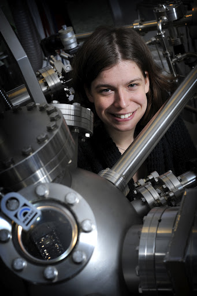Reconstructions at complex oxide interfaces
Promotion date: 23. March 2012
Promotors: Prof. dr. ing. Guus Rijnders and Prof. dr. ing. Dave Blank
Assistant promotor: Dr. ir. Gertjan Koster
| The research was concentrated on complex oxide materials fabricated by pulsed laser deposition. By combining several oxide crystals in a controlled way (atomic layer by atomic layer) new materials with a combination of interesting properties could be fabricated. As a result of change in composition and structure at the interface between two complex oxides, new functionalities defined at the interface can be gained, while these functionalities are still absent in the bulk. Here, the research was focused on the manipulation and understanding of these complex oxide interfaces. For example, LaAlO3 and SrTiO3 are both wide band gap insulators. But when one deposits a thin layer of LaAlO3 on SrTiO3, the interface becomes electronically conducting. Additionally, the interface can even become superconducting or magnetic. Besides this material system, several other material systems were studied, focusing on various types of interface behavior. |
Was your thesis work fundamental?
Yes, it was. By using pulsed laser deposition, one can fabricate ultrathin layers of complex oxide materials with atomic precision. These materials would never occur naturally. For my research, I was especially interested in the electronic and magnetic properties at the interface between different layers, trying to understand what exactly is taking place there.
My research is not focused on applications in the near future. Nonetheless, it may be used for certain applications at some point, e.g. in solar cells. Solar cells consist of several crucial components. One of them is the electrode. The top electrode should be transparent to light (otherwise no solar energy) but also conducting. However, conducting materials are normally opaque. I’ve fabricated transparent, conducting interfaces between two insulating materials. This makes these materials very interesting, being transparent and conductive.
How do you come across these combinations of layers?
Sometimes, we have an intuitive physical model. As a result, we design material combinations for which we expect amazing property changes near the interface. We created a material system, for example, where the electron transfer at the interface was really amazing. However, we still have to improve the functionalities, like magnetic properties, for these material systems. This is something we are now continuing on in collaboration with theorists
Can you recall a special moment during your thesis project?
Together with a bachelor student we developed a surface treatment for certain complex oxide crystals. This surface treatment should result in chemically well defined and smooth surfaces: an important step for further research. Subsequently, we had to prove that the surface was indeed chemically well-defined.
On a Friday afternoon, we were doing an experiment to prove that we succeeded in achieving such a well-defined surface. Seeing the sample performing like you hope for is amazing. Finally, it led to nice publications with our partners from the universities of Nijmegen and Berkeley.
Did you manage to have some nice publications along the way?
We had several publications, for example in Advanced Functional Materials, Physical Review Letters and Nano Letters. Moreover, I was a speaker on the Materials Research Society Meeting in Boston, and also at national meetings in Veldhoven and the annual meeting of Mesa+. At several conferences I had a poster presentation, e.g. in San Francisco and Naples. And soon, I am glad to present my more recent research in San Francisco.
In what way did you develop as a scientist and experimentalist in these years?
On too many facets than I am able to mention. My lab skills are much better now, as is my knowledge of this specific research field. In the beginning I needed help from skilled researchers. Now I’m helping others out which is, I believe, very important for our Inorganic Materials Science group.
What are your future plans?
I am looking for a post-doc position abroad, as I like academic research. I would like to develop my skills in another country and in another research community with a different approach and culture.
Looking further into the future, I leave open possibilities both in academic research and industry.
Did you feel like a member of the Mesa+ institute?
Yes, very much so. I was, for example, involved in the opening ceremony of the brand new nanolab. Moreover, I had the privilege to show people around, including pupils from schools here in Twente.
Mesa+ should always try to find new, bold types of research, staying focused in a clear line of research. Furthermore, Mesa+ is really good in explaining the interest in nanotechnology to laypeople. Being open to pupils from schools is vital, learning them that scientific research is neither nerdy nor boring.

